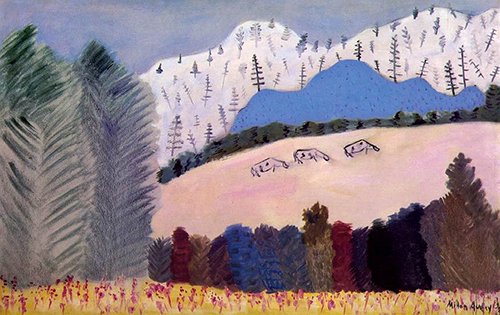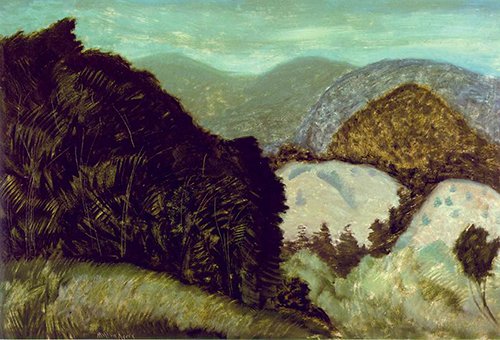Simply Colour
 Gaspé – Pink Sky, 1940Can you believe I had never heard of the painter Milton Avery before today? Thanks to Pinterest I discovered his beautiful paintings. The large stretches of almost flat colour of the first one I saw, Gaspé – Pink Sky (1940) immediately put me in mind of Rothko, except that it was representational. What I love about it besides the muted tertiary hues is the simplicity of the stylised shapes that form the landscape, and indeed all his compositions.
Gaspé – Pink Sky, 1940Can you believe I had never heard of the painter Milton Avery before today? Thanks to Pinterest I discovered his beautiful paintings. The large stretches of almost flat colour of the first one I saw, Gaspé – Pink Sky (1940) immediately put me in mind of Rothko, except that it was representational. What I love about it besides the muted tertiary hues is the simplicity of the stylised shapes that form the landscape, and indeed all his compositions.
 Seated Lady, 1953
Seated Lady, 1953 Conversation, 1956Avery (1885–1965) is considered a seminal American painter but seemed to have suffered from first being ahead of his times (too abstract early in his career), and when the times caught up and Abstract Expressionism bypassed him, he was dismissed as being too representational.
Conversation, 1956Avery (1885–1965) is considered a seminal American painter but seemed to have suffered from first being ahead of his times (too abstract early in his career), and when the times caught up and Abstract Expressionism bypassed him, he was dismissed as being too representational.
Like Rothko, he was concerned with the relation of colour as opposed to creating the illusion of depth, and was influenced early on by French Fauvism and German Expressionism. He was likened to an American Matisse (another of my favourite artists), and the art critic Hilton Kramer said of him:
“He was, without question, our greatest colorist … Among his European contemporaries, only Matisse—to whose art he owed much, of course—produced a greater achievement in this respect.” [Wikipedia]
 Three Cows on a Hillside, 1945
Three Cows on a Hillside, 1945 Fall in Vermont, 1935
Fall in Vermont, 1935 Horse in a Landscape, 1941
Horse in a Landscape, 1941 Vermont Hills, 1936Working in New York City in the 1930s–40s he became a part of the artistic community and in fact friends with Mark Rothko, who paid him a high compliment:
Vermont Hills, 1936Working in New York City in the 1930s–40s he became a part of the artistic community and in fact friends with Mark Rothko, who paid him a high compliment:
“What was Avery’s repertoire? His living room, Central Park, his wife Sally, his daughter March, the beaches and mountains where they summered; cows, fish heads, the flight of birds; his friends and whatever world strayed through his studio: a domestic, unheroic cast. But from these there have been fashioned great canvases, that far from the casual and transitory implications of the subjects, have always a gripping lyricism, and often achieve the permanence and monumentality of Egypt.” [Wikipedia]
Read about him in more detail here.
 Yellow Sky, 1958
Yellow Sky, 1958 Interlude, 1960Images from Wikiart and Pinterest.
Interlude, 1960Images from Wikiart and Pinterest.

